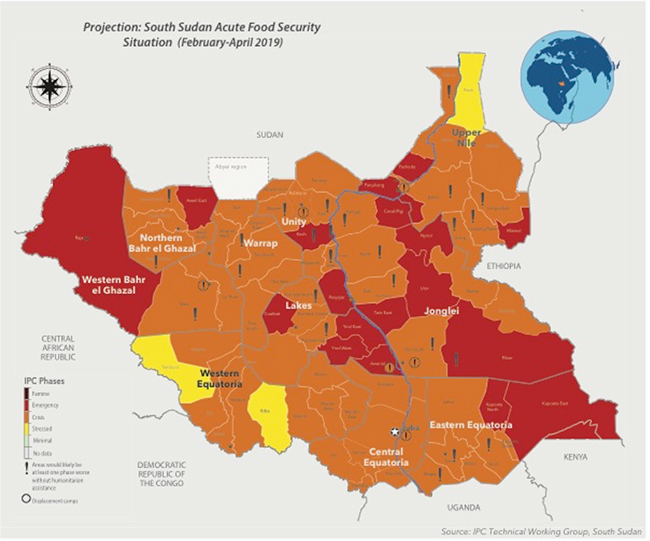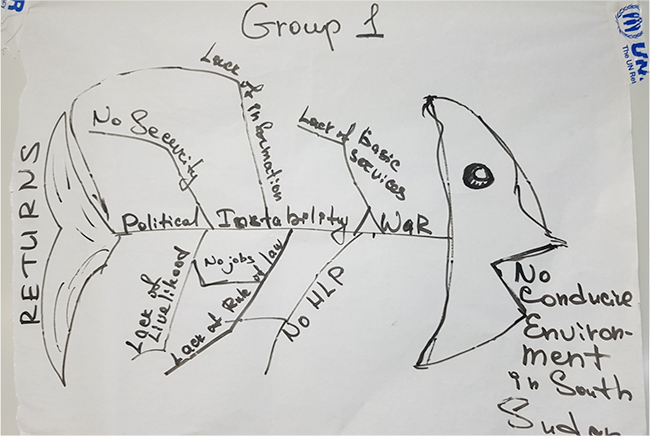Following the peace deal signed in September 2018 and known as Revitalised Agreement on the Resolution of the Conflict in South Sudan (R-ARCSS), spontaneous IDP and refugee returns have increased despite continuing pockets of insecurity in the country. This has led actors on the ground, including the government and humanitarian partners working under the umbrella of the Protection Cluster, to engage in work geared towards informing context-based solutions strategies.
To further advance these efforts, UNHCR, on behalf of the South Sudanese Protection Cluster, requested JIPS’ support to design and implement a solutions analysis. During a scoping mission conducted in April, two of JIPS’ profiling advisors, Devora Levakova and Margharita Lundkvist-Houndoumadi, travelled to South Sudan to support partners in assessing the challenges and information needs for a solutions analysis in light of the recent return movements.
South Sudan, the world’s youngest nation, has known civil war for most of its short existence. According to OCHA estimates, since December 2013 there have been about 1.84 million internally displaced people (IDPs) in the country, whilst 2 million people have sought refuge in neighbouring countries.
Despite some remaining pockets of insecurity, there are opportunities to implement contextualised solutions in different areas in the country. The South Sudanese government itself has taken steps that could lay the foundation for such solutions initiatives, including the approval of the National Framework for the Return, Resettlement and Reintegration of Displaced Persons (in early 2017), and the development of an IDP law submitted to the parliament for endorsement. Additionally, a number of localised solutions-related activities, including context-specific guidance (1) by the Humanitarian Country Team and pilot projects such as in Bentiu, are being implemented.

Map of the levels of food security concerns across all regions of South Sudan. Source: Integrated Food Security Phase Classification (IPC).
Though there is a vision towards solutions, various regions in the country are still in an emergency state and face a number of challenges: beyond the changing political context, the prevalent food insecurity and deep-rooted tribal disputes over land and cattle that long predate the conflict add to the complexity of the displacement situation.
Ensuring that national and local authorities, humanitarian and development actors, as well the returning IDP and refugee communities themselves can overcome these numerous challenges requires a thorough assessment of solutions strategies to aid returning communities in the long term.
Starting off in the South Sudanese capital, Juba, our profiling advisors Devora and Margharita met with representatives from the Protection Cluster and the Inter-Cluster Working Group (ICWG), as well as with South Sudanese governmental entities including the Ministry of Humanitarian Affairs and Disaster Management (MHADM), the Relief and Rehabilitation Commission (RRC), and the National Bureau of Statistics. Bilateral meetings were also held with humanitarian and development actors working in the country, including UNHCR, IOM, OCHA, UNDP, REACH and the Danish Refugee Council.
They then travelled to the city of Malakal, the capital of the northeastern Upper Nile State. There, they facilitated a workshop with the main humanitarian and development stakeholders involved in the Solutions Working Group (SWG) active in the area and UNMISS, to look more specifically at key challenges linked to returns in the Upper Nile State and information and analysis needs to inform solutions.
The discussions both in Juba and Malakal helped to bring profiling partners on the same table, especially in regards to three key aspects in light of a solutions analysis:

A ‘fishbone diagram’ used by participants to identify key challenges linked to return in Upper Nile, as well as the factors causing these challenges.
Despite an encouraging legal and policy environment and local solutions strategies, several difficulties were highlighted throughout the discussions. This led partners to elaborate and broadly agree on a number of key recommendations for conducting a solutions analysis:
As part of the immediate next steps following the mission, we are currently supporting profiling partners in clarifying objectives of a potential collaborative profiling exercise, as well as in identifying and establishing a formal collaborative structure to guide the solutions analysis. Another important step is to explore the possibility of a full-time profiling coordinator to act as a focal point for both Juba and field actors across the country throughout the process. Stay tuned to hear more on how this profiling exercise develops.
—–
Want to know more about how to conduct a durable solutions analysis? Visit the Durable Solutions Indicator Library or get in touch with us at info@jips.org, or find us on our pages on Facebook, LinkedIn or Twitter.
1 The Guidance Note on Solutions-Based Approach to Displaced Populations in South Sudan (2017) was developed by the Humanitarian Country Team to guide the work on solutions as well as local level Solutions Working Group Strategies. The guidance is an an updated version of the Interim Operational Guidance Note on Returns and Relocations in South Sudan, developed by the HCR in 2016.